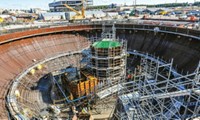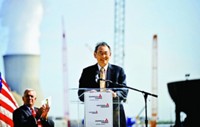Advertisement
Grab your lab coat. Let's get started
Welcome!
Welcome!
Create an account below to get 6 C&EN articles per month, receive newsletters and more - all free.
It seems this is your first time logging in online. Please enter the following information to continue.
As an ACS member you automatically get access to this site. All we need is few more details to create your reading experience.
Not you? Sign in with a different account.
Not you? Sign in with a different account.
ERROR 1
ERROR 1
ERROR 2
ERROR 2
ERROR 2
ERROR 2
ERROR 2
Password and Confirm password must match.
If you have an ACS member number, please enter it here so we can link this account to your membership. (optional)
ERROR 2
ACS values your privacy. By submitting your information, you are gaining access to C&EN and subscribing to our weekly newsletter. We use the information you provide to make your reading experience better, and we will never sell your data to third party members.
Energy
Permit Sought For New U.S. Reactors
Construction application is first in 29 years
by Jeff Johnson
October 1, 2007
| A version of this story appeared in
Volume 85, Issue 40

Two energy providers applied last week to the Nuclear Regulatory Commission (NRC) for a "combined construction and operating license" for two new nuclear power plants with a combined output of 2,700 MW. The submission marks the first construction application for new nuclear plants in the U.S. in 29 years.
NRG Energy and South Texas Project Nuclear Operating Co. plan to build the reactors at their facility near Bay City, Texas, which already houses two similarly sized reactors.
"We have chosen an NRC-certified and an operationally proven technology," noted NRG President and CEO David W. Crane. "We expect to build these facilities on time and on budget."
The application is the first to use a new NRC process to speed up issuance of a construction and operating license. NRC has already approved the design and the site; the company expects to receive a license within 42 months, begin construction in 2010, and be operating by 2014. It expects the facilities to cost $6 billion.
NRG will be first in line to obtain a host of benefits available to early builders of new nuclear power plants, company officials note. The benefits include risk insurance for regulatory delays and legal challenges worth $500 million for the first two reactors and $250 million for the next four; a tax credit worth 1.8 cents per kWh, comparable with that provided to wind energy suppliers; and loan guarantees worth up to 80% of the total construction cost.
After a dismal recent construction history due to cost overruns and canceled construction projects, nuclear power is looking better because of growing electricity demand and its lack of carbon dioxide emissions.
Much uncertainty remains for nuclear power, however, particularly because of financing needs and the fate of nuclear waste. Still, the Nuclear Energy Institute says more than 30 nuclear power plants are being considered for the U.S.




Join the conversation
Contact the reporter
Submit a Letter to the Editor for publication
Engage with us on Twitter